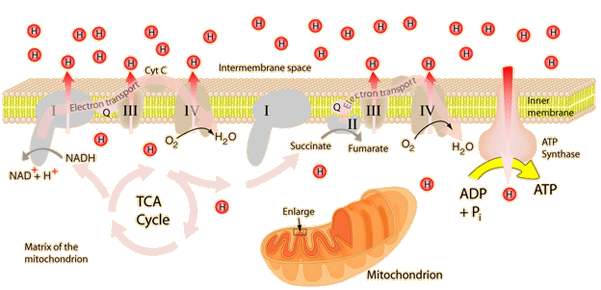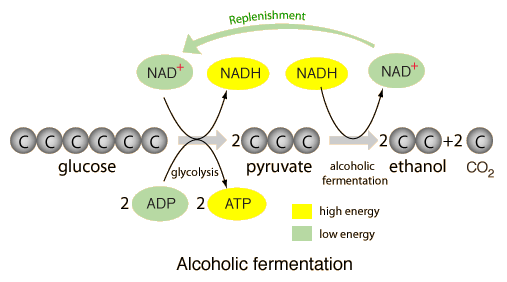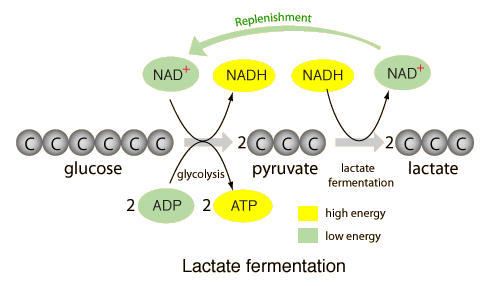- Unlike photosynthesis, all living cells undergo cellular respiration. Cellular respiration is the breakdown of chemical bonds to release energy in the form of Adenosine Triphosphate (ATP).
- There are two types of cellular respiration:
|
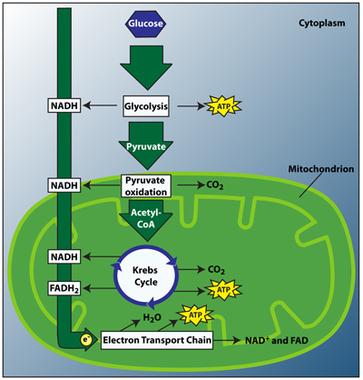 Click on image to be taken to the source.
Click on image to be taken to the source. Aerobic Respiration
Cellular respiration in an oxygenated environment. Aerobic respiration yields a large amount of ATP.
Aerobic respiration can be summarized in three
(sometimes four, depending on how you divide the steps up) steps:
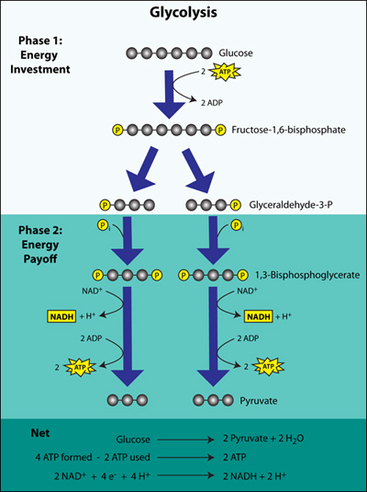 Click on image to be taken to the source.
Click on image to be taken to the source. 1) Glycolysis - In glycolysis, glucose is broken down in the cytoplasm. Glycolysis can be split into two different sub-phases, the "preparatory phase" and the "payoff phase".
1.5) Transition - In the transitory step, pyruvate molecules are taken to the mitochondria to be converted into a compound called acetyl coenzyme A, or acetyl CoA. This produces NADH and CO2 as a byproduct.
- Preparatory phase (Energy investment): Two molecules of ATP are used to convert glucose into a specific fructose molecule, which is then split in half.
- Payoff phase (Energy payoff): Each half of the fructose molecule, now known as a glyceraldehyde, is further processed until each half becomes a molecule of pyruvate. This processing yields two molecules of ATP, totaling four molecules of ATP from one molecule of glucose. However, two molecules of ATP were used in the preparatory phase, so the net ATP produced is two molecules.
1.5) Transition - In the transitory step, pyruvate molecules are taken to the mitochondria to be converted into a compound called acetyl coenzyme A, or acetyl CoA. This produces NADH and CO2 as a byproduct.
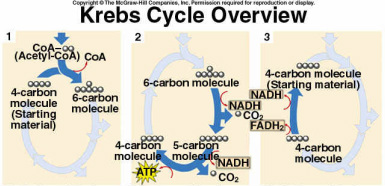 Click on image to be taken to the source.
Click on image to be taken to the source. 2) Citric Acid Cycle/Krebs Cycle - In the Krebs Cycle, oftentimes known as the Citric Acid Cycle, acetyl CoA is combined with a four-carbon molecule and turned into citrate, a six-carbon molecule. Citrate is then repeatedly oxidized (loses electrons in the form of hydrogen in NADH and FADH2, which will be used in the next step) until only the beginning four-carbon molecule and 2CO2 is left -- the waste product of aerobic respiration. The oxidation of citrate produces two more molecules of ATP. This cycle takes place in the mitochondrial matrix.
3) Electron Transport Chain - In the electron transport chain, a series of oxidation-reduction reactions (RedOx review: oxidation is loss of electrons, reduction is gain of electrons) take place within the inner membranes of the mitochondria. A series of four pumps are powered by electrons, provided by the NADH and FADH2 produced in the earlier steps of respiration, to pump protons (H+) into intermembrane space. The fourth pump uses the O2 reactant to create the H2O byproduct of cellular respiration. A final fifth pump, ATP synthase, takes the protons and produces ATP in large amounts. The electron transport chain produces the majority of the ATP made in cellular respiration, 34 molecules.
Crashcourse on YouTube has a nice video on aerobic respiration, which is a nice review of the above information. (x)
Anaerobic Respiration
In the absence of oxygen, respiration still occurs, but the ATP yield is much smaller. Glycolysis, the first step in aerobic respiration, does not require oxygen. Thus, anaerobic respiration is in essence glycolysis taking place multiple times in an effort to produce enough ATP to sustain the cell without the consumption of oxygen. In an anaerobic environment, ATP is generated exclusively in the cytoplasm, as glycolysis takes place solely in the cytoplasm.
